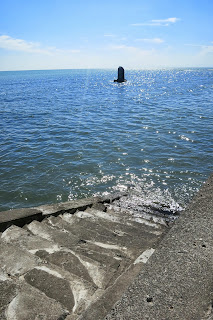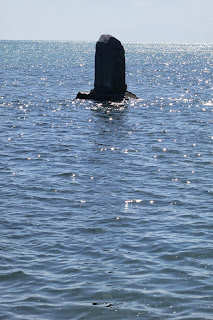It has been a while since my last post. I guess that is because we really settling into life here, and as much as I would love to vacation and sight-see every day, the reality is we live here and we are just keeping busy doing non-blog worthy stuff - grocery shopping, date nights, BBQ's with friends, beach days, CME activities, work, learning Japanese, etc.
I have been spending quite a bit of time using Rosetta Stone to learn Japanese and it has its ups and downs. Japanese is a difficult language to use and I have been frustrated with Rosetta Stone. We have heard good things about Pimsler, and are looking into investing into that program. I have made progress however, and am able to ask for simple things and carry on brief, polite snipits of conversation with the locals.
A couple weekends ago, there was a large festival at one of the Shinto Shrines in Kamukura, right near our house and the main event featured Yabusame, which is samurai style mounted archery. Samurai ride horses down the shrines paths, shooting arrows at various targets. Unfortunately, a typhoon ruined our fun and it was cancelled. Turns out, the typhoon was basically a small tropical storm, nothing like the one currently carrying out some devastation in China and the Philippines. Hopefully, we don't encounter any as large as that during our time here. They are quite frequent, another one is supposed to affect us in the next 1-3 days.
The day before the typhoon we went with a group of friends to Tokyo for the Belgian Beer Festival. It was great beer and great people.
In honor of Kenny, I will talk a little about beer/alcohol in Japan. Beer is the most common alcoholic beverage served in Japan, even above sake. Because of Japan's tax system, they distinguish the varieties of malt beverages into 2 groupings: beer (biru) and happoshu. Happoshu are low malt beverages (less than 67%), and have taken a large part of the beer market here since the tax is lower. Up until 1994, the only big beer players here were Kirin, Asahi, Sapporo and Suntory, due to strict tax laws that negatively affected smaller breweries from gaining any momentum. These laws denied a brewery a license to produce alcoholic beverages unless they were producing 2 million liters per year. In 1994, these laws were relaxed and now Japan is home to over 200 microbreweries (much to Kenny's joy). We have found a local watering hole just down the street from us who rotates microbrews it offers on tap and bottle, so needless to say, pretty much every date night we spend some time at this place. :)
Due to this new found treasure of Kenny's, it has also exposed to me some of the other popular types of alcohol in Japan. Between the bartenders fairly good English, and my very limited Japanese, we discovered (and he was appalled), that I had not heard of, or tried Shochu before. I had thought all along that Sake was the most popular liquor in Japan, but it turns out that Shochu is considered the national spirit of Japan and has outsold sake in the past decade. They call it Japanese whisky. Honestly, it really tastes quite a bit like sake. However, while Shochu is a distilled spirit, sake is actually brewed (even though it is described as rice wine) and is more like rice beer than rice wine. Shochu appears to be distilled in a similar fashion as vodka, and can utilize a variety of raw materials such as barley, rice or sweet potatoes. Needless to say, despite the bartenders continued samples of each kind of Shochu - it must be an aquired taste that I don't have. :)
Moving on.... The day after the typhoon was a beautiful one, and I set out to attempt a hike up a nearby (small) mountain to a park with views of Mt. Fuji. Up until this point, the weather has been slightly unbearable (humid, hot), and therefore hazy, so views of Mt. Fuji would have been impossible. However, this day was amazing and the view was spectacular. To get to this point however, I had to climb quite a hill through a very narrow, steep and overgrown path. It was about 1/2 mile, I'm guessing, and I pretty much ran the entire way because I was deathly afraid of coming across a snake. Luckily, I didn't. :) Here are some pictures of the hike, the beach, and the VIEW! :)
 |
| On extremely clear days, you can see Mt. Fuji from our beach :) |
From what I have discovered (and the information is limited, so it might be wrong), the monument was placed in the 1930's, praising the novel "Hototogisu" written by auther Tokutomi in 1898. Apparently, the novel depicts the victimization of women (especially young brides) during that time period. Elderly Japanese women apparently can still recite the novel's heroine lament over the burdens of her gender: "Aa tsurai! tsurai! Mo - mo - mo onna nanzo ni - umarewashimasengo" ("It's more than I can bear, It's more than I can bear. I'll never, never, never be born a woman again.")
Back to my favorite thing in Japan: FOOD! Some dessert pictures/descriptions, first is MOCHI:
Mochi is... well... interesting, to say the least. It reminds me of eating raw dough, but not necessarily in a good way. These treats can be found year-round, but are mostly commonly served around the New Year. It is a Japanese rice cake made of mochigome - which is a short-grain, glutinous rice. The rice is soaked overnight and then cooked. Then, it is pounded repeatedly with wooden mallets. I think there is more modern equipment that does this these days, but below is a video of the classic technique. I don't think you necessary have to move this fast either - but these guys are good. :)
\
Mochi can be used to make many different varieties of sweets. In my picture, the brown one on the left is called a daifuku, which is a soft mochi filled with red or white bean paste. The one on the right is mochi made from a flour of sweet rice - mixed with water to make a opaque mass that is cooked until elastic and slightly transparent. There is also mochi ice cream, which I have not yet tried.
The other dessert is Taiyaki (which means baked sea bream), and is a fish shaped cake:
It is made using pancake or waffle batter, and I have seen them sold crispy like a cookie, or soft like a cake (which I prefer). You can put anything inside - bean paste, custard, chocolate, sweet potato, sausage or gyoza filling. The most common is red bean paste. This paste finds its way into everything. I'm developing a taste for it, but it is definitely different. It is basically Azuki beans (red beans), that are boiled and mashed, adding sugar or honey for sweetness.


It comes in a variety of consistencies - I find the smoother, the better. Mmmmm, red bean paste. Haha :)
To close, I had a great day today as I got to go stand up paddleboarding! So much fun. A friend of mine and I went (although it turns out they wouldn't rent to her since she is pregnant, bummer), but she lounged on the beach and took pictures while I SUP'ed around the area and even rode a few waves in on the board (on my knees!). If I wasn't hooked before on this sport, I really am now and since we live so close to the beach, we are going to look into getting one. ;)
Until next time - sayounara!

It comes in a variety of consistencies - I find the smoother, the better. Mmmmm, red bean paste. Haha :)
To close, I had a great day today as I got to go stand up paddleboarding! So much fun. A friend of mine and I went (although it turns out they wouldn't rent to her since she is pregnant, bummer), but she lounged on the beach and took pictures while I SUP'ed around the area and even rode a few waves in on the board (on my knees!). If I wasn't hooked before on this sport, I really am now and since we live so close to the beach, we are going to look into getting one. ;)
Until next time - sayounara!









































































